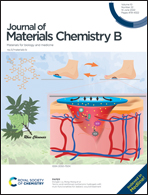Nitric oxide-propelled nanomotors for bacterial biofilm elimination and endotoxin removal to treat infected burn wounds
Abstract
Biofilm infection is regarded as a major contributing factor to the failure of burn treatment and a persistent inflammatory state delays healing and leads to the formation of chronic wounds. Herein, self-propelled nanomotors (NMs) are proposed to enhance biofilm infiltration, bacterial destruction, and endotoxin clearance to accelerate the healing of infected burn wounds. Janus nanoparticles (NPs) were prepared through partially coating Fe3O4 NPs with polydopamine (PDA) layers, and then polymyxin B (PMB) and thiolated nitric oxide (SNO) donors were separately grafted onto the Janus NPs to obtain IO@PMB-SNO NMs. In response to elevated glutathione (GSH) levels in biofilms, NO generation from one side of the Janus NPs leads to self-propelled motion and deep infiltration into biofilms. The local release of NO could destroy bacteria inside the biofilm, which provides a non-antibiotic antibiofilm approach without the development of drug resistance. In addition to intrinsic antibacterial effects, the PMB grafts preferentially bind with bacteria and the active motion enhances lipopolysaccharide (LPS) clearance and then significantly attenuates the production of inflammatory cytokines and reactive oxide species by macrophages. Partial-thickness burn wounds were established on mice and infected with P. aeruginosa, and NM treatment almost fully destroyed the bacteria in the wounds. IO@PMB-SNO NMs absorb LPS and remove it from the wounds under a magnetic field, which downregulates the interleukin-6 and tumor necrosis factor-α levels in tissues. The infected wounds were completely healed with the deposition and arrangement of collagen fibers and the generation of skin features similar to those of normal skin. Thus, IO@PMB-SNO NMs achieved multiple-mode effects, including GSH-triggered NO release and self-propelled motion, the NO-induced non-antibiotic elimination of biofilms and bacteria, and PMB-induced endotoxin removal. This study offers a feasible strategy, with integrated antibiofilm and anti-inflammatory effects, for accelerating the healing of infected burn wounds.



 Please wait while we load your content...
Please wait while we load your content...